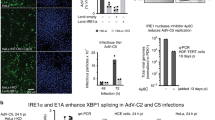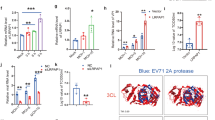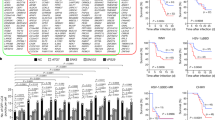Abstract
Interferons (IFNs) mediate cellular defence against viral pathogens by upregulation of IFN-stimulated genes whose products interact with viral components or alter cellular physiology to suppress viral replication1,2,3. Among the IFN-stimulated genes that can inhibit influenza A virus (IAV)4 are the myxovirus resistance 1 GTPase5 and IFN-induced transmembrane protein 3 (refs 6,7). Here, we use ectopic expression and gene knockout to demonstrate that the IFN-inducible 219-amino acid short isoform of human nuclear receptor coactivator 7 (NCOA7) is an inhibitor of IAV as well as other viruses that enter the cell by endocytosis, including hepatitis C virus. NCOA7 interacts with the vacuolar H+-ATPase (V-ATPase) and its expression promotes cytoplasmic vesicle acidification, lysosomal protease activity and the degradation of endocytosed antigen. Step-wise dissection of the IAV entry pathway demonstrates that NCOA7 inhibits fusion of the viral and endosomal membranes and subsequent nuclear translocation of viral ribonucleoproteins. Therefore, NCOA7 provides a mechanism for immune regulation of endolysosomal physiology that not only suppresses viral entry into the cytosol from this compartment but may also regulate other V-ATPase-associated cellular processes, such as physiological adjustments to nutritional status, or the maturation and function of antigen-presenting cells.
This is a preview of subscription content, access via your institution
Access options
Access Nature and 54 other Nature Portfolio journals
Get Nature+, our best-value online-access subscription
$29.99 / 30 days
cancel any time
Subscribe to this journal
Receive 12 digital issues and online access to articles
$119.00 per year
only $9.92 per issue
Buy this article
- Purchase on Springer Link
- Instant access to full article PDF
Prices may be subject to local taxes which are calculated during checkout



Similar content being viewed by others
Data availability
The datasets generated and/or analysed during the current study are available from the corresponding authors on reasonable request.
Change history
22 January 2019
In the version of Supplementary Fig. 5a originally published with this Letter, the authors mistakenly duplicated images of LAMP1 staining in place of CD63 staining; this has now been amended to the correct version shown below.
References
Doyle, T., Goujon, C. & Malim, M. H. HIV-1 and interferons: who’s interfering with whom? Nat. Rev. Microbiol. 13, 403–413 (2015).
McNab, F., Mayer-Barber, K., Sher, A., Wack, A. & O’Garra, A. Type I interferons in infectious disease. Nat. Rev. Immunol. 15, 87–103 (2015).
Randall, R. E. & Goodbourn, S. Interferons and viruses: an interplay between induction, signalling, antiviral responses and virus countermeasures. J. Gen. Virol. 89, 1–47 (2008).
Iwasaki, A. & Pillai, P. S. Innate immunity to influenza virus infection. Nat. Rev. Immunol. 14, 315–328 (2014).
Haller, O. & Kochs, G. Human MxA protein: an interferon-induced dynamin-like GTPase with broad antiviral activity. J. Interferon Cytokine Res. 31, 79–87 (2011).
Brass, A. L. et al. The IFITM proteins mediate cellular resistance to influenza A H1N1 virus, West Nile virus, and dengue virus. Cell 139, 1243–1254 (2009).
Everitt, A. R. et al. IFITM3 restricts the morbidity and mortality associated with influenza. Nature 484, 519–523 (2012).
Goujon, C. & Malim, M. H. Characterization of the alpha interferon-induced postentry block to HIV-1 infection in primary human macrophages and T cells. J. Virol. 84, 9254–9266 (2010).
Goujon, C. et al. Human MX2 is an interferon-induced post-entry inhibitor of HIV-1 infection. Nature 502, 559–562 (2013).
Yu, L. et al. Induction of a unique isoform of the NCOA7 oxidation resistance gene by interferon β-1b. J. Interferon Cytokine Res. 35, 186–199 (2015).
Naldini, L. et al. In vivo gene delivery and stable transduction of nondividing cells by a lentiviral vector. Science 272, 263–267 (1996).
Herold, N. et al. HIV-1 entry in SupT1-R5, CEM-ss, and primary CD4+ T cells occurs at the plasma membrane and does not require endocytosis. J. Virol. 88, 13956–13970 (2014).
Mercer, J., Schelhaas, M. & Helenius, A. Virus entry by endocytosis. Annu. Rev. Biochem. 79, 803–833 (2010).
Banerjee, I., Yamauchi, Y., Helenius, A. & Horvath, P. High-content analysis of sequential events during the early phase of influenza A virus infection. PLoS ONE 8, e68450 (2013).
Banerjee, I. et al. Influenza A virus uses the aggresome processing machinery for host cell entry. Science 346, 473–477 (2014).
Webster, R. G., Brown, L. E. & Jackson, D. C. Changes in the antigenicity of the hemagglutinin molecule of H3 influenza virus at acidic pH. Virology 126, 587–599 (1983).
Shelton, H., Roberts, K. L., Molesti, E., Temperton, N. & Barclay, W. S. Mutations in haemagglutinin that affect receptor binding and pH stability increase replication of a PR8 influenza virus with H5 HA in the upper respiratory tract of ferrets and may contribute to transmissibility. J. Gen. Virol. 94, 1220–1229 (2013).
Russier, M. et al. Molecular requirements for a pandemic influenza virus: an acid-stable hemagglutinin protein. Proc. Natl Acad. Sci. USA 113, 1636–1641 (2016).
Shao, W., Halachmi, S. & Brown, M. ERAP140, a conserved tissue-specific nuclear receptor coactivator. Mol. Cell. Biol. 22, 3358–3372 (2002).
Durand, M. et al. The OXR domain defines a conserved family of eukaryotic oxidation resistance proteins. BMC Cell. Biol. 8, 13 (2007).
Merkulova, M. et al. Mapping the H+ (V)-ATPase interactome: identification of proteins involved in trafficking, folding, assembly and phosphorylation. Sci. Rep. 5, 14827 (2015).
Huttlin, E. L. et al. The BioPlex network: a systematic exploration of the human interactome. Cell 162, 425–440 (2015).
Merkulova, M. et al. Targeted deletion of the Ncoa7 gene results in incomplete distal renal tubular acidosis in mice. Am. J. Physiol. Renal Physiol. 315, F173–F185 (2018).
Trombetta, E. S., Ebersold, M., Garrett, W., Pypaert, M. & Mellman, I. Activation of lysosomal function during dendritic cell maturation. Science 299, 1400–1403 (2003).
Cotter, K., Stransky, L., McGuire, C. & Forgac, M. Recent insights into the structure, regulation, and function of the V-ATPases. Trends Biochem. Sci. 40, 611–622 (2015).
Bright, N. A., Davis, L. J. & Luzio, J. P. Endolysosomes are the principal intracellular sites of acid hydrolase activity. Curr. Biol. 26, 2233–2245 (2016).
Wang, Z., Berkey, C. D. & Watnick, P. I. The Drosophila protein mustard tailors the innate immune response activated by the immune deficiency pathway. J. Immunol. 188, 3993–4000 (2012).
Colacurcio, D. J. & Nixon, R. A. Disorders of lysosomal acidification—the emerging role of v-ATPase in aging and neurodegenerative disease. Ageing Res. Rev. 32, 75–88 (2016).
Sennoune, S. R. & Martinez-Zaguilan, R. Vacuolar H+-ATPase signaling pathway in cancer. Curr. Protein Pept. Sci. 13, 152–163 (2012).
Cavrois, M., De Noronha, C. & Greene, W. C. A sensitive and specific enzyme-based assay detecting HIV-1 virion fusion in primary T lymphocytes. Nat. Biotechnol. 20, 1151–1154 (2002).
Mangeot, P. E. et al. High levels of transduction of human dendritic cells with optimized SIV vectors. Mol. Ther. 5, 283–290 (2002).
Saenz, D. T., Teo, W., Olsen, J. C. & Poeschla, E. M. Restriction of feline immunodeficiency virus by Ref1, Lv1, and primate TRIM5α proteins. J. Virol. 79, 15175–15188 (2005).
O’Rourke, J. P., Newbound, G. C., Kohn, D. B., Olsen, J. C. & Bunnell, B. A. Comparison of gene transfer efficiencies and gene expression levels achieved with equine infectious anemia virus- and human immunodeficiency virus type 1-derived lentivirus vectors. J. Virol. 76, 1510–1515 (2002).
Jarrosson-Wuilleme, L. et al. Transduction of nondividing human macrophages with gammaretrovirus-derived vectors. J. Virol. 80, 1152–1159 (2006).
Sandrin, V. et al. Lentiviral vectors pseudotyped with a modified RD114 envelope glycoprotein show increased stability in sera and augmented transduction of primary lymphocytes and CD34+ cells derived from human and nonhuman primates. Blood 100, 823–832 (2002).
Wickersham, I. R., Finke, S., Conzelmann, K. K. & Callaway, E. M. Retrograde neuronal tracing with a deletion-mutant rabies virus. Nat. Methods 4, 47–49 (2007).
Tran, V., Moser, L. A., Poole, D. S. & Mehle, A. Highly sensitive real-time in vivo imaging of an influenza reporter virus reveals dynamics of replication and spread. J. Virol. 87, 13321–13329 (2013).
Walters, K. A. et al. Genomic analysis reveals a potential role for cell cycle perturbation in HCV-mediated apoptosis of cultured hepatocytes. PLoS Pathog. 5, e1000269 (2009).
Sanjana, N. E., Shalem, O. & Zhang, F. Improved vectors and genome-wide libraries for CRISPR screening. Nat. Methods 11, 783–784 (2014).
Blight, K. J., McKeating, J. A. & Rice, C. M. Highly permissive cell lines for subgenomic and genomic hepatitis C virus RNA replication. J. Virol. 76, 13001–13014 (2002).
Mangeot, P. E. et al. Protein transfer into human cells by VSV-G-induced nanovesicles. Mol. Ther. 19, 1656–1666 (2011).
Schindelin, J. et al. Fiji: an open-source platform for biological-image analysis. Nat. Methods 9, 676–682 (2012).
Lindenbach, B. D. et al. Complete replication of hepatitis C virus in cell culture. Science 309, 623–626 (2005).
Catanese, M. T. et al. Different requirements for scavenger receptor class B type I in hepatitis C virus cell-free versus cell-to-cell transmission. J. Virol. 87, 8282–8293 (2013).
Sakai, T. et al. Dual wavelength imaging allows analysis of membrane fusion of influenza virus inside cells. J. Virol. 80, 2013–2018 (2006).
Acknowledgements
We thank W. Barclay, F. Blanchet, M. Bonazzi, L. Espert, M. Huttunen, J. Long, E. Martinez, J. Mercer, D. Muriaux, P. Rocha, R. Schulz and Y. Yamauchi for generous provision of reagents and helpful discussions. We are grateful to A. Vaughan for instruction in IAV amplification, P. J. Chana (Biomedical Research Centre (BRC) Flow Core) for training and advice on imaging flow cytometry, I. Ali (King’s College London Nikon Imaging Centre) for advice with confocal microscopy and image acquisition, I. Parham for help with the time-lapse microscopy, and M. Boyer and B. Monterroso (‘MRI’ imaging and flow cytometry facility) for cell sorting and advice with flow cytometry and confocal microscopy, respectively. This work was supported by the UK Medical Research Council (G1000196 to M.H.M.), the Wellcome Trust (106223/Z/14/Z to M.H.M.), the NIH (DA033773), a Wellcome Trust Research Training Fellowship and National Institute for Health Research BRC King’s Prize Fellowship (to T.D.), the Institut National de la Santé et de la Recherche Médicale (to C.G.), the European Research Council under the European Union’s Horizon 2020 research and innovation programme (grant agreement number 759226 to C.G.), the ATIP-Avenir Program (to C.G.), institutional funds from the Centre National de la Recherche Scientifique and Montpellier University (to C.G.), France Recherche Nord & Sud Sida/HIV et Hépatites (to O.M.), a PhD studentship from the Ministry of Higher Education and Research (to B.B.), King’s College London departmental start-up funds (to M.-T.C.), and the Department of Health via a National Institute for Health Research BRC award to Guy’s and St. Thomas’ NHS Foundation Trust in partnership with King’s College London and King’s College Hospital NHS Foundation Trust. We acknowledge the imaging facility MRI, a member of the national infrastructure France-BioImaging supported by the French National Research Agency (ANR-10-INBS-04).
Author information
Authors and Affiliations
Contributions
T.D., O.M., M.-T.C., C.G. and M.H.M. conceived and designed the experiments. T.D., O.M., B.B., D.P., M.L., M.T., L.A. and C.G. performed the experiments. All authors analysed the data. T.D., C.G. and M.H.M. wrote the manuscript with input from all authors.
Corresponding authors
Ethics declarations
Competing interests
The authors declare no competing interests.
Additional information
Publisher’s note: Springer Nature remains neutral with regard to jurisdictional claims in published maps and institutional affiliations.
Supplementary information
Supplementary Information
Supplementary Figures 1–6
Supplementary Movie 1
NCOA7 inhibits IAV infection. 293T cells constitutively expressing CD8 or NCOA7 were plated in 48-well plates and transfected with a GFP reporter construct responsive to the IAV RNA polymerase. Cells were infected with A/Eng/195/2009 and visualized by time-lapse microscopy. Productive infection is reflected by GFP expression; time post infection is indicated. The experiment was repeated independently three times with similar results.
Rights and permissions
About this article
Cite this article
Doyle, T., Moncorgé, O., Bonaventure, B. et al. The interferon-inducible isoform of NCOA7 inhibits endosome-mediated viral entry. Nat Microbiol 3, 1369–1376 (2018). https://doi.org/10.1038/s41564-018-0273-9
Received:
Accepted:
Published:
Issue Date:
DOI: https://doi.org/10.1038/s41564-018-0273-9
This article is cited by
-
Decrease of Cellular Communication Network Factor 1 (CCN1) Attenuates PTZ-Kindled Epilepsy in Mice
Cellular and Molecular Neurobiology (2023)
-
Molecular basis of mEAK7-mediated human V-ATPase regulation
Nature Communications (2022)
-
Lessons in self-defence: inhibition of virus entry by intrinsic immunity
Nature Reviews Immunology (2022)
-
Bidirectional genome-wide CRISPR screens reveal host factors regulating SARS-CoV-2, MERS-CoV and seasonal HCoVs
Nature Genetics (2022)
-
The evolutionary conserved TLDc domain defines a new class of (H+)V-ATPase interacting proteins
Scientific Reports (2021)



